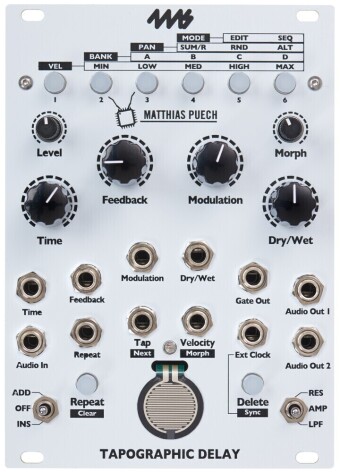4MS Tapographic Delay



 42 670 р. предложить свою цену
45642
42 670 р. предложить свою цену
45642
Купить сейчас
Добавить в корзину
Уведомить о снижении цены
Уведомить о поступлении товара
The Tapographic Delay is a dynamically playable echo module with up to 32 rhythmic signal repeats. Simply tap on the sensor surface to program atmospheric, silky soft sounding delay sequences. Via velocity, it is possible to control the volume, a low-pass or a resonant band-pass filter. The latter generates great click sounds. Complex rhythms can be recorded in several runs. Completed rhythms can be saved. Furthermore, there are morph and link options. On top of all that, the Tapographic Delay is also usable as a trigger sequencer. – An ingenious module!
The Tapographic Delay is a digital effects processor with velvety soft, high-resolution sound. Echo sequences can be recorded directly via a pressure-sensitive sensor on the front-panel. – Highly intuitive! Up to 32 taps can be placed in a pattern, each with individual velocity and pan settings. The velocity values affect either the volume or the cutoff frequency of a filter which can be activated per step. In detail, a low-pass without resonance or a sharpened band-pass filter can be selected. The latter is great for creating echos with click noises. Results sound very modern and cool. The maximum delay time is 174 seconds, meaning almost three minutes.
Recorded echo sequences can be supplemented with additional taps. You can either insert steps within the existing pattern or add them at the end. A time potentiometer scales the distance of all taps by a factor from about 0.1 to about 4. The modulation knob adds some wow and flutter reminiscent of old tape recorders. A feedback potentiometer is available as well. Turned fully clockwise, this parameter leads to a continuous built-up in sound, which has a roaring, yet still musical character. A dry / wet potentiometer allows musicians to mix raw material and effect signals. Additionally, there is a level knob at the effect’s input. Almost all parameters of the Tapographic Delay are voltage controllable. A clock input can be used for synchronization. Alternatively to inputting rhythms via the sensor, it is possible to program the module via tap and velocity connectors. Thanks to a gate output, musicians can utilize theTapographic Delay as a trigger sequencer.
Finalized patterns can be saved in four banks with six storage slots each. The knob positions are not saved, so that the “basic sound” is retained while changing sequences. Furthermore, there is a morph function. A sequencer mode with various running directions makes it possible to link several patterns.
Заводская спецификация и комплектация с сайта производителя
The Tapographic Delay is a digital effects processor with velvety soft, high-resolution sound. Echo sequences can be recorded directly via a pressure-sensitive sensor on the front-panel. – Highly intuitive! Up to 32 taps can be placed in a pattern, each with individual velocity and pan settings. The velocity values affect either the volume or the cutoff frequency of a filter which can be activated per step. In detail, a low-pass without resonance or a sharpened band-pass filter can be selected. The latter is great for creating echos with click noises. Results sound very modern and cool. The maximum delay time is 174 seconds, meaning almost three minutes.
Recorded echo sequences can be supplemented with additional taps. You can either insert steps within the existing pattern or add them at the end. A time potentiometer scales the distance of all taps by a factor from about 0.1 to about 4. The modulation knob adds some wow and flutter reminiscent of old tape recorders. A feedback potentiometer is available as well. Turned fully clockwise, this parameter leads to a continuous built-up in sound, which has a roaring, yet still musical character. A dry / wet potentiometer allows musicians to mix raw material and effect signals. Additionally, there is a level knob at the effect’s input. Almost all parameters of the Tapographic Delay are voltage controllable. A clock input can be used for synchronization. Alternatively to inputting rhythms via the sensor, it is possible to program the module via tap and velocity connectors. Thanks to a gate output, musicians can utilize theTapographic Delay as a trigger sequencer.
Finalized patterns can be saved in four banks with six storage slots each. The knob positions are not saved, so that the “basic sound” is retained while changing sequences. Furthermore, there is a morph function. A sequencer mode with various running directions makes it possible to link several patterns.
характеристики
Скачать мануал 4MS Tapographic Delay
